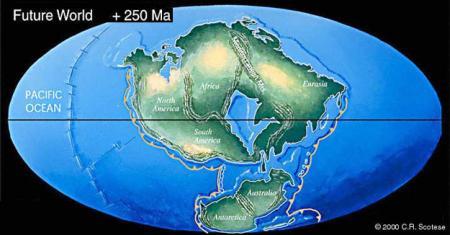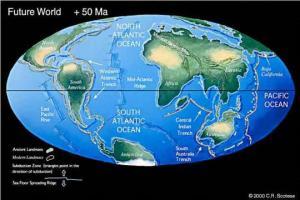The Earth will look vastly different 250 million years from now.
Africa is expected to collide with Europe, while Australia drifts northward to join with Asia. At the same time, the Atlantic Ocean may continue to expand briefly before reversing its direction and eventually vanishing.
Two hundred and fifty million years ago, Earth’s landmasses were united in a supercontinent known as Pangea. In a striking case of history repeating itself, the current continents are gradually moving toward one another and are projected to form a new supercontinent called Pangea Ultima.

Above: A speculative map of the Earth as it might look 250 million years from now. Most of the world’s landmass has merged into a single supercontinent called “Pangea Ultima,” complete with an inland sea—the remnant of the once-vast Atlantic Ocean. Map courtesy of Dr. Christopher Scotese.
The Earth’s surface is divided into massive plates that slowly drift in a process known as “plate tectonics.” By analyzing geological evidence and tracing the historical movement of continents, Dr. Christopher Scotese, a geologist at the University of Texas at Arlington, has developed an informed projection of how the continents might shift over the next hundreds of millions of years.
“Of course, we can’t know the future with certainty,” Scotese explained. “But we can make educated predictions about how the plates will move, what changes might occur, and where the continents could end up.” One of these predictions suggests that Africa will continue its northward movement, eventually closing the Mediterranean Sea and forming a Himalayan-scale mountain range in southern Europe.
Africa has been slowly colliding with Europe for millions of years, according to Scotese. “Italy, Greece, and much of the Mediterranean region are part of the African plate, which has been colliding with Europe for the past 40 million years,” he explained.
This ongoing collision has driven the formation of the Alps and the Pyrenees mountains and is responsible for the earthquakes that occasionally strike regions like Greece and Turkey.

Above: A possible depiction of the Earth 50 million years from now. Africa has merged with Europe, closing off the Mediterranean Sea. The Atlantic Ocean has widened, and Australia has shifted northward. Map courtesy of Dr. Christopher Scotese.
“The Mediterranean is the remnant of a much larger ocean that has been closing for the past 100 million years, and this process will continue,” Scotese noted. “As the plates keep moving, more of the region will be compressed and pushed upward, eventually forming mountain ranges comparable to the Himalayas.”
Australia is also expected to continue its northward migration, eventually merging with the Eurasian continent.
“Australia is moving north and has already begun colliding with the southern islands of Southeast Asia,” Scotese explained. “If we extend that motion into the future, the left shoulder of Australia becomes stuck, causing the continent to rotate and eventually collide with Borneo and southern China—much like how India collided with Asia 50 million years ago—ultimately becoming part of Asia.”
At the same time, the Americas will continue drifting further from Africa and Europe as the Atlantic Ocean gradually expands. This widening is driven by a massive underwater mountain ridge that runs along the ocean floor from north to south. Here, molten rock from Earth’s interior rises to the surface, creating new sea floor material. As this process continues, the two halves of the Atlantic sea floor slowly spread apart, causing the ocean to grow wider.
“It’s about as fast as your fingernails grow, maybe a little slower,” Scotese explained. Yet, over millions of years, this seemingly tiny movement will gradually drive the continents apart.
This aspect of the prediction is relatively reliable, as it simply extrapolates current tectonic motions. However, projecting beyond 50 million years into the future becomes increasingly complex.
“The challenge lies in predicting new behaviors,” Scotese said. “It’s like driving on a highway—you can estimate where you’ll be in an hour, but unexpected events, like an accident or a detour, can change your direction. We need to understand what triggers those changes. That’s where we start making educated guesses for the distant future, 150 to 250 million years from now.”
For the expanding Atlantic, geologists believe a “subduction zone” will eventually emerge along its eastern or western edges. Subduction zones occur when the ocean floor sinks beneath the edge of a continent, plunging into Earth’s interior.
“The subduction zone is the key to understanding what drives plate movements,” Scotese explained.
Similar to how cold air descends from an attic in winter, the cold, dense ocean floor at the edges of the Atlantic can sometimes begin sinking into the semi-fluid layer beneath the Earth’s crust, known as the “mantle.” This sinking process plays a crucial role in shaping the movement of tectonic plates.

Above: A diagram illustrating the key processes of plate tectonics. Image credit: NASA
“As the plate sinks, it pulls the rest of the plate along with it,” Scotese explained, likening the motion to a tablecloth sliding off a table. This “slab pull” effect accounts for most of the force driving the movement of tectonic plates.
This modern theory contrasts sharply with the older “river raft” model of plate tectonics.
“For many years, geologists believed in a model where ‘conveyor belts’ of mantle convection carried the continents passively, like rafts floating on a river,” Scotese said. “But that theory has been thoroughly debunked.”
If a subduction zone develops on one side of the Atlantic—Scotese predicts it will be the western side—it would gradually begin dragging the ocean floor into the mantle. As this process unfolds, the mid-Atlantic ridge, where new sea floor is created, would eventually be pulled beneath the Earth’s surface. This would halt the Atlantic’s expansion and initiate its gradual shrinking.
Over tens of millions of years, this shift would drive the Americas to collide with the combined Euro-African continent, forming a towering range of Himalayan-scale mountains along the collision zone. By this time, most of the Earth’s landmasses would have coalesced into a supercontinent known as “Pangea Ultima.” The collision could also trap a large inland sea, Scotese noted.
“It’s all speculative, of course,” he admitted. “But it’s fascinating to imagine what might happen. This kind of projection is only possible if we have a clear understanding of the processes driving these movements in the first place.”
If these predictions hold true, in 250 million years, the Earth’s continents will merge once again into a single massive landmass—just as they were 250 million years ago. From Pangea, to the present, and back to Pangea Ultima!